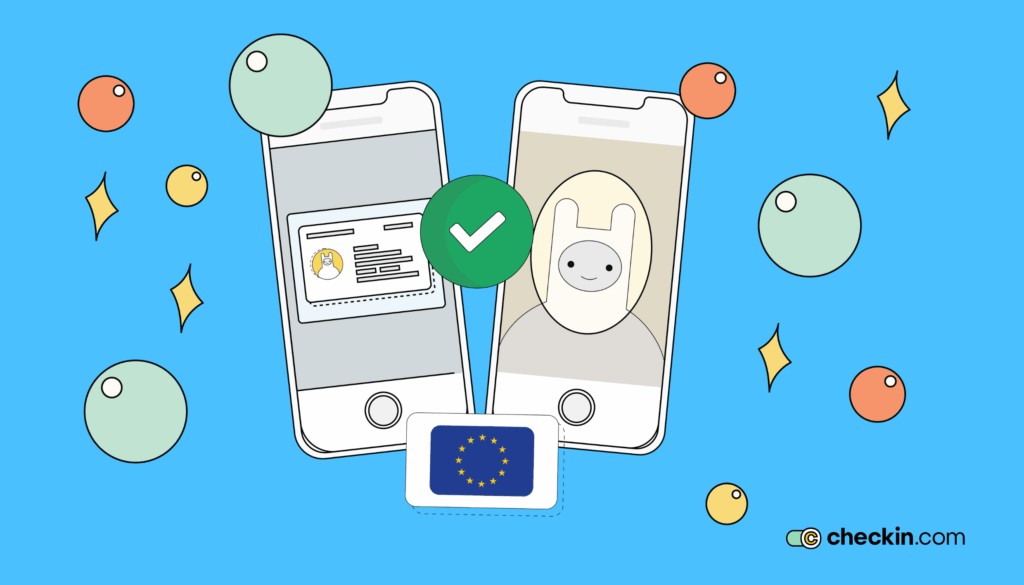
“Are you over 18?” Yup.
It’s that easy for kids to lie about their ages when faced with a self-declaration form.
Ticking a box won’t protect your business. And it won’t protect the kids using your platform.
EU regulators know it, too. That’s why they’re cracking down.
From the Digital Services Act to national age verification (AV) laws, self-declaration is officially out and biometric measures are in.
And businesses that don’t upgrade face fines, legal action, and reputational damage.
Let’s explore how EU age verification laws are changing and why intelligent AV software is the answer to staying compliant and keeping children safe.
Why is strong age verification important for companies operating in the EU?
Weak age verification systems expose your business to risk.
In the EU, age verification laws are tightening fast. Businesses are expected to put strong age verification measures in place or face serious legal fallout.
And for good reason.
Over one-third of organizations say underage users have attempted to access their online services. Despite this high figure, most companies still rely on self-declaration — nothing more than a simple “I’m over 18” checkbox. Only 28% have installed biometric age assurance to combat these attempts.
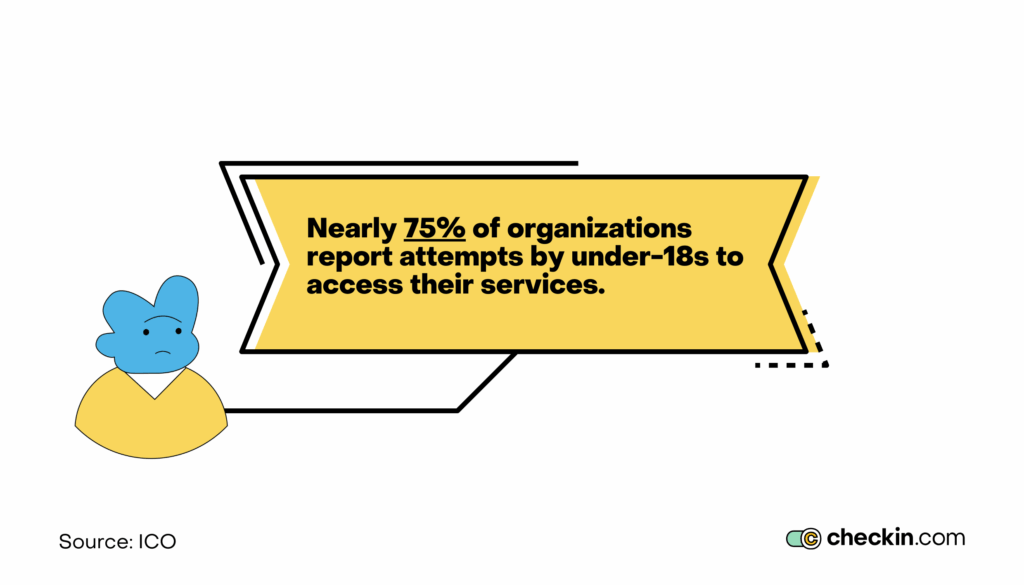
And it’s not just children bypassing age gates. AI-generated content is playing its part.
Adults with malicious intent exploit AI to fake their way past age verification systems to pose as minors. And this content is getting harder to detect with the naked eye, with 59% of people saying they struggle to tell whether media is real or fake.
This puts minors in serious danger.
A large majority of teens have already witnessed graphic or violent material online, and 75% have been exposed to sexual content. Among teens, 76% experience online bullying, and nearly one in five 8- to 16-year-olds have been approached by an online predator.
This is why the EU is cracking down.
Age verification is becoming a legal and ethical necessity. And if you don’t comply, you risk fines, business closures, or worse.
What’s the EU’s approach to age verification and how's this changing?
Age verification is no longer a checkbox exercise.
EU regulators are clear. Users must confirm their age with legitimate proof.
Robust age verification measures are now expected across all digital services that restrict minors.
Here’s a look at how the EU's approach to age verification is changing.
Age verification is becoming a regulatory priority
EU-wide age verification legislation is getting stricter.
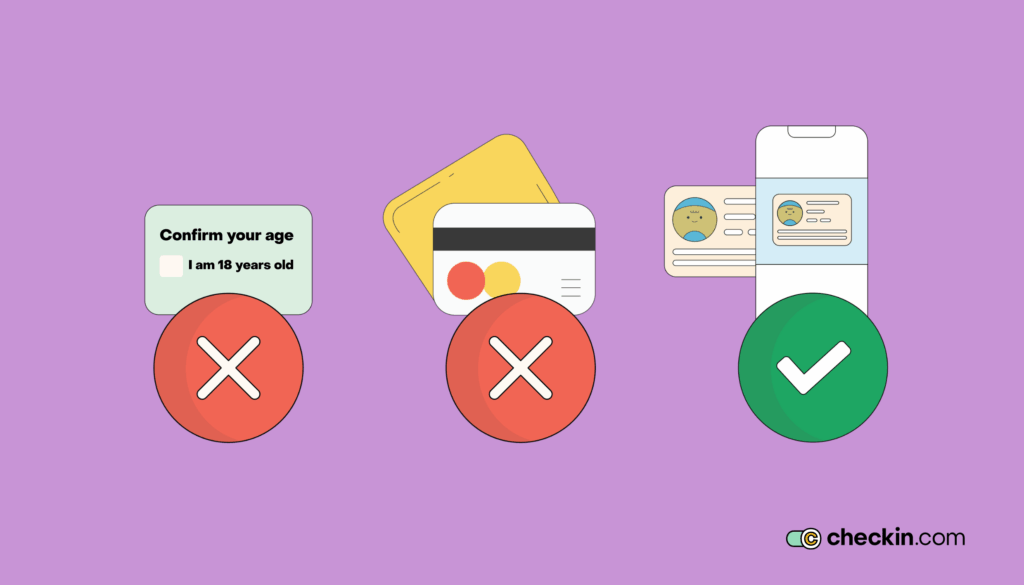
Take the Digital Services Act (DSA) and the Audiovisual Media Services Directive (AVMSD).
Both now insist that platforms actively prevent minors from accessing age-inappropriate content. Self-declaration checkboxes no longer qualify as “effective” age assurance methods.
The DSA has a tiered structure with stricter obligations for larger platforms. Services are compelled to find risks to minors, fix them, and instil strong age verification tools.
The AVMSD expands this coverage to include streaming and video-sharing platforms.
On top of this, the European Data Protection Board (EDPB) is also drafting new guidance around privacy. Statement 1/2025 states that age checks must be fair, private, and risk-based. Tools like age tokens and zero-knowledge proofs are preferred to preserve the privacy of minors.
Regulatory pressure is also mounting at the state level, with countries like France, Germany, and Spain introducing their own standards.
It’s not just about restricting content. It’s about building trustworthy digital platforms that take serious measures to protect minors.
Businesses must evolve with the standards to stay compliant and competitive across the EU.
Privacy and data minimization are central concerns
All EU age checks must follow GDPR and local privacy laws.
Companies can only collect the data that’s needed, and they mustn’t store it for too long. It’s imperative that companies never use age checks to track minors or profile them for marketing purposes.
Transparency is also essential.
Users must understand what data the age verification system collects and why. These systems should also be independent from the platforms they service to avoid conflicts of interest.
Lack of harmonization drives call for unified laws
As it stands, each EU Member State sets its own age assurance rules.
This patchwork of laws, technical standards, and regulatory bodies is a real headache for companies that operate across borders.
With no unified framework, compliance feels like a full time job. Teams need to stay on top of changes in multiple jurisdictions or risk non-compliance penalties.
To simplify the situation, the EU plans to release the European Digital Identity Wallet by 2026.
The digital ID wallet offers a standardized, privacy-first solution for digital identification and age verification. Users can securely prove their age across all Member States without oversharing personal details.
Digital wallets and national ID schemes are emerging
Some countries are already ahead of the EU’s Digital Identity Wallet scheme.
Spain has launched Cartera Digital, and Italy uses its SPID system to verify ages online.
These tools link official IDs to age verification, while still protecting privacy.
Soon, platforms will have to accept digital ID checks as a form of age verification across the EU.
Non-compliance brings serious penalties
Ignoring age verification rules comes with heavy penalties.
Under the DSA, companies can be fined 6% of their worldwide turnover.
France is threatening fines of up to €150,000 or 2% of the previous year’s global turnover, whoever is higher. Germany will take legal action against companies that don't follow their laws about protecting young people.
Just look at the UK.
In 2023, OFCOM fined MintStars £7,000 for not protecting children from explicit content.
The message is crystal clear. Strong privacy-first age checks are mandatory, and those who fail to meet the criteria will be punished.
What are the age verification laws and guidance in the EU? Side-by-side overview
Here’s a quick overview of EU and national age verification laws, their requirements, regulatory bodies, and penalties.
| Region | Legislation | Regulatory Body | Main Provisions | Penalties |
| EU | General Data Protection Regulation (GDPR) | National Data Protection Authorities | Parental consent required for underage data processing; age verification mechanisms required | Up to €20M or 4% of global turnover |
| EU | Audiovisual Media Services Directive (AVMSD) | National AV Regulators | Video platforms must protect minors; age verification encouraged | Varies by country; may include fines and content restrictions |
| EU | Digital Services Act (DSA) | European Commission & Member States | Large platforms must assess and mitigate risks to minors; age checks may be required | Up to 6% of global turnover |
| EU | EU Digital Identity Framework | European Commission | Provides digital credentials (e.g. age) via EUDI Wallet; supports cross-border age verification | Varies by country |
| UK | Online Safety Act 2023 | Ofcom | Mandatory age checks for adult content; platforms must mitigate risks to minors | Up to £18M or 10% of global turnover |
| UK | Age-Appropriate Design Code | Information Commissioner's Office (ICO) | Services likely accessed by children must use age-appropriate settings and verification | GDPR-aligned fines |
| France | SREN Law (Law No. 2020–936) | ARCOM | Mandates reliable age verification to block minors from accessing pornographic content | Criminal sanctions, site blocking, fines |
| Germany | Jugendmedienschutz-Staatsvertrag (JMStV) | KJM (Kommission für Jugendmedienschutz) | Requires AV systems to restrict adult content; no self-declaration allowed | Fines and legal action |
| Spain | AEPD Age Verification Guidance | AEPD | 10 principles for privacy-preserving age checks; supports digital wallet integration | Fines under GDPR/national law |
| Italy | AGCOM Regulation 9/23/CONS | AGCOM | Requires robust AV for adult content; AGCOM lists compliant providers | Fines and platform blocking |
| Ireland | Online Safety and Media Regulation Act (2022) | Coimisiún na Meán | Empowers regulator to enforce child safety rules, including age verification mandates | Up to €20M or 10% of turnover |
Why conventional age verification methods don’t align with EU laws
Outdated age systems don’t meet today’s standards.
But while 63% of organisations say they use age assurance methods, only a fifth have plans to upgrade to better age verification technology.
This gap poses a major compliance risk.
Here’s why.
It’s too easy to bypass self-declaration
Self declaration checkboxes are the most common age verification method.
But companies don’t use self declaration because it’s accurate. They use it because it’s easy. In fact, 63% of organisations that use this method say they chose it because it was simple to implement.
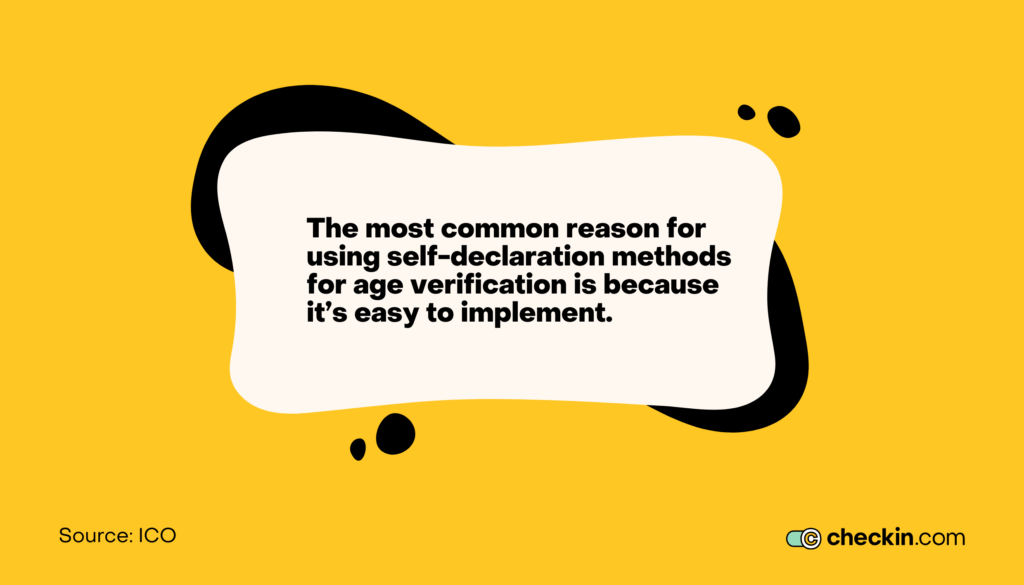
But as easy as it is to install, it’s even easier to fake. Almost half of children aged 8–15 with social media profiles list their ages as 16 or older.
That’s a direct breach of the DSA and the AVMSD.
Outdated systems can’t spot AI-generated spoofs
People aren’t good at spotting AI fakes. Manual checks and legacy tools are no match for synthetic identities or AI-generated photos.
Children and adults with bad intent can easily slip through weak systems using deepfakes.
If companies fail to catch these spoofs, they face huge non-compliance penalties and risk children’s safety.
Weak verification enables exposure to harm
When minors come face to face with age-inappropriate content, everyone loses.
Minors risk exposure to pornographic content, online predators, and graphic material. Businesses face reputational fallout, legal backlash, and financial penalties.
The only way to reduce this risk is with strong age verification.
Poor verification gives access to illegal or age-restricted goods
It’s not just harmful content that’s an issue.
Inadequate checks allow minors to access age-restricted goods and services, such as alcohol, tobacco, and gambling platforms.
Not only is this illegal, it’s also unsafe. For businesses selling these goods and services, underage access jeopardizes their operating license.
Platforms fail to protect children’s personal data
Without proper age checks, you may be unwittingly collecting data from minors. This is a direct violation of the GDPR and can result in hefty fines.
Just look at TikTok.
The social platform was fined $16 million by the ICO. By failing to keep under-13s off the platform, it was inadvertently collecting and storing children’s data — a GDPR breach.
How to stay compliant with age verification laws in the EU
So what’s the most effective way to stay compliant and creating a safe environment for minors — especially with regulations changing so frequently?
Here are some tips.
1. Know the rules in all the countries you operate in
EU regulations are still so fragmented, despite the changes afoot.
While most regulations aim to protect underage users from harmful content, each EU Member State has its own quirks. Different supervisory authority, ranging age thresholds, and varying enforcement pathways.
To stay compliant, digital service providers need to understand what’s needed for each of the countries they operate in and the EU at large.
Audit your online platforms against national-level laws as well as future EU schemes.

Pro tip: Look for a tool like Checkin.com that’s built for global compliance. It automatically adjusts age verification flows based on country-specific rules. This makes sure you’re compliant at all times, without interrupting the user experience.
2. Identify where age assurance is legally required
Many organization make incorrect assumptions about age assurance. They think it’s reserved for pornographic sites and gambling websites.
In reality, any digital platform offering age-inappropriate content or age-restricted goods needs to implement age assurance methods.
But it’s not just tobacconists and adult sites that need to worry.
Social media networks, video-sharing platforms, and any site with user-generated content also needWhy's age verification.
Why? Because it’s nearly impossible to monitor every post in real time. This leaves the door open for underage users to run into age-inappropriate content accidentally.
Map your services against high-risk content categories. If minors might find a way to access it, robust age verification systems are required.
3. Upgrade your verification methods to AI-driven age assurance software
Data shows that 56% of organizations say accuracy is their most important decision factor when choosing age verification tools.
In this sense, self-declaration, credit card checks, and parental consent aren’t effective age verification systems.
To meet age verification technology standards, you should adopt AI-driven methods, such as:
- Document authentication
- 1:1 and 1:N biometric verification
- Liveness detection
- Deepfake detection
- Facial age estimation
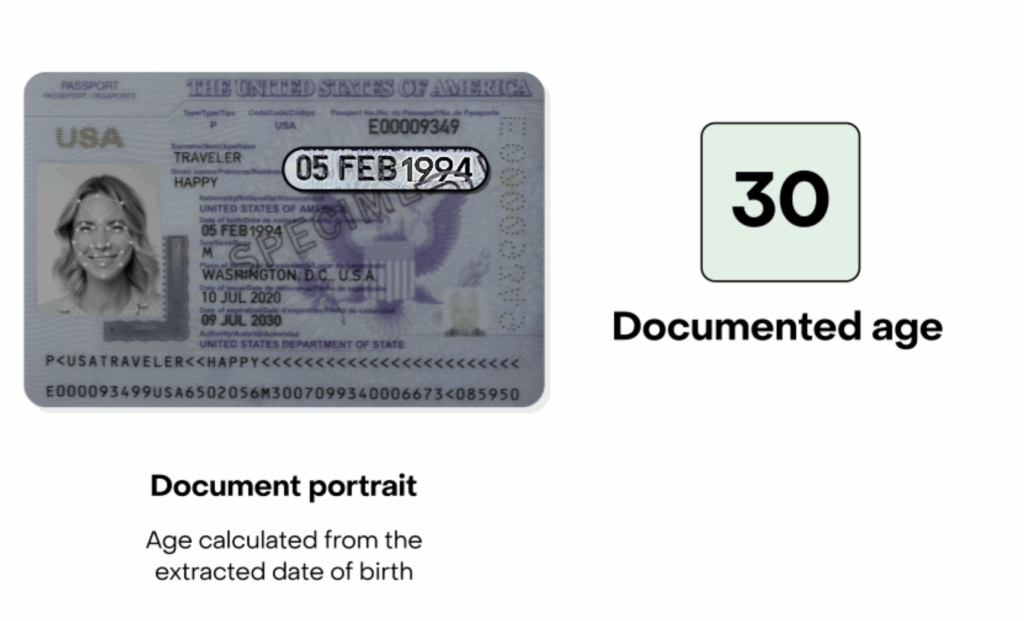
These tools verify the age of users with high precision. And they’re almost impossible to cheat.
With platforms like Checkin.com, the whole process takes under five seconds. Not only do you stay compliant, it’s also a smooth digital experience for users.
4. Choose a privacy-respecting verification tool
User privacy is just as important as accuracy. That’s why a third of businesses say it’s the most important factor when choosing a tool.
Since your tool must comply with GDPR, look for solutions that:
- Minimize data
- Avoid storing raw images
- Support data residency in the EU or US
- Built-in parental authority and consent options
Checkin.com is built with privacy-by-design principles.
Instead of keeping full selfies, it stores data as biometric vectors. This ensures strong protection while ensuring a high level of accuracy.
5. Localize the user experience
If your age check flow doesn’t feel intuitive, users will abandon the process.
For companies that work across borders, you’ll need to localize verification flows so users can access age checks in their own language.
You’ll also need fast verification with clear instructions, no matter which jurisdictions you operate in.
Make sure your age assurance tool:
- Works across devices
- Offers multilingual support
- Completes verification in seconds
- Matches local UX expectations
This is where Checkin.com excels. It customizes the full verification experience across 80+ languages, adapting to device type and regional formats.
6. Keep records and enable auditing
Regulatory authorities want proof of effective implementation.
Companies need to keep logs and create exportable records that demonstrate that your age assurance techniques work.
Your age verification system should have built-in audit trails and reporting dashboards, as well as usage analytics to track activity patterns and spot issues.
Final thoughts
EU age assurance laws are tightening fast.
Outdated methods no longer cut it. They leave you vulnerable to non-compliance and children in the wake of harm.
From content platforms to ecommerce, every business with age-restricted content or services needs a system that’s fast, accurate, and privacy-first.
Checkin.com helps you meet complex EU regulations with ease. Its AI-driven, localized verification flows protect users and evolve to meet changing regulations.
Don’t wait for a fine or PR disaster to act.
Upgrade your age assurance now. Stay ahead of the law, not behind it.